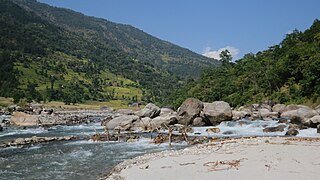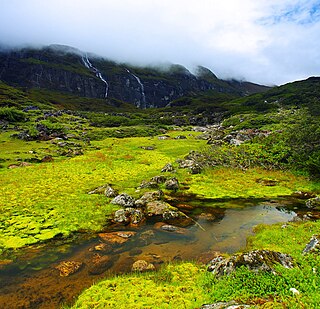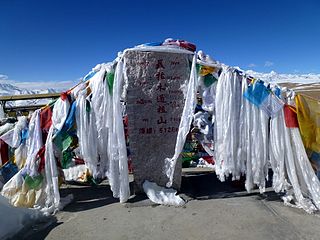
Nepal measures about 880 kilometers (547 mi) along its Himalayan axis by 150 to 250 kilometers across. It has an area of 147,516 km2 (56,956 sq mi).

The Himalayas,or Himalaya is a mountain range in Asia,separating the plains of the Indian subcontinent from the Tibetan Plateau. The range has some of the Earth's highest peaks,including the highest,Mount Everest;more than 100 peaks exceeding elevations of 7,200 m (23,600 ft) above sea level lie in the Himalayas.

The geography of Tibet consists of the high mountains,lakes and rivers lying between Central,East and South Asia. Traditionally,Western sources have regarded Tibet as being in Central Asia,though today's maps show a trend toward considering all of modern China,including Tibet,to be part of East Asia. Tibet is often called "the roof of the world," comprising tablelands averaging over 4,950 metres above the sea with peaks at 6,000 to 7,500 m,including Mount Everest,on the border with Nepal.

The Tamur River is a major river in eastern Nepal,which begins around Kanchenjunga. The Tamor and the Arun join the Sun Koshi at Tribenighat to form the giant Saptakoshi which flows through Mahabharat Range on to the Gangetic plain.

The Friendship Highway is an 800-kilometre (500 mi) scenic route connecting the capital of Tibet,Lhasa,with the Chinese/Nepalese border at the Sino-Nepal Friendship Bridge between Zhangmu and Kodari. It includes the westernmost part of China National Highway 318 (Shanghai-Zhangmu) and crosses three passes over 5,000 m (16,400 ft) before dropping to 1,750 m (5,700 ft) at the border.
Tsangpo is the Tibetan word for river. It can often be found as a suffix attached to names of rivers originating or sometimes flowing through the Tsang province of Tibet,including:

The Kosi or Koshi is a transboundary river which flows through China,Nepal and India. It drains the northern slopes of the Himalayas in Tibet and the southern slopes in Nepal. From a major confluence of tributaries north of the Chatra Gorge onwards,the Kosi River is also known as the Saptakoshi for its seven upper tributaries. These include the Tamur River originating from the Kanchenjunga area in the east and Arun River and the Sun Kosi from Tibet. The Sun Koshi's tributaries from east to west are the Dudh Koshi,Likhu Khola,Tamakoshi River,Bhote Koshi and Indravati. The Saptakoshi crosses into northern Bihar,India where it branches into distributaries before joining the Ganges near Kursela in Katihar district. The Kosi is the third-largest tributary of the Ganges by water discharge after the Ghaghara and the Yamuna.

A glacial lake outburst flood (GLOF) is a type of outburst flood caused by the failure of a dam containing a glacial lake. An event similar to a GLOF,where a body of water contained by a glacier melts or overflows the glacier,is called a jökulhlaup. The dam can consist of glacier ice or a terminal moraine. Failure can happen due to erosion,a buildup of water pressure,an avalanche of rock or heavy snow,an earthquake or cryoseism,volcanic eruptions under the ice,or massive displacement of water in a glacial lake when a large portion of an adjacent glacier collapses into it.

Nyalam is a small town in and the county seat of Nyalam County in the Shigatse Prefecture of the Tibet Autonomous Region,near the Nepal border. It is 35 km from Zhangmu town in the same county,which is the point of entry to Nepal. Nyalam is situated at 3,750 metres (12,300 ft) above sea level.

The Arun River is a trans-boundary river and is part of the Kosi or Sapt Koshi river system in Nepal. It originates in Tibet Autonomous Region of the People's Republic of China where it is called the Phung Chu or Bum-chu.
Mahālangūr Himāl is a section of the Himalayas in northeast Nepal and south-central Tibet of China extending east from the pass Nangpa La between Rolwaling Himal and Cho Oyu,to the Arun River. It includes Mount Everest,Lhotse,Makalu,and Cho Oyu —four of Earth's six highest peaks. On the Tibetan side it is drained by the Rongbuk and Kangshung Glaciers and on the Nepali side by Barun,Ngojumba and Khumbu Glaciers and others. All are tributaries to the Koshi River via Arun River on the north and east or Dudh Kosi on the south.

The Indravati River in Nepal is a tributary of the Sun Koshi River. It used to be called "Melamchi" or "Melamchu" until the 19th century.

The Barun River is a tributary of the Arun River and is part of the Kosi river system in Nepal.

The Trishuli River is one of the major tributaries of the Narayani River basin in central Nepal. The river is formed by the merger of the Kyirong Tsangpo and the Lende Khola originating in Gyirong County of Tibet,which join together near the Rasuwa Gadhi on the Nepal–Tibet border. The valley of the river used to be the traditional trade route between the Kathmandu Valley and Tibet.

The Sunkoshi,also spelt Sunkosi,is a river that is part of the Koshi or Saptkoshi River system in Nepal. Sunkoshi has two source streams,one that arises within Nepal in Choukati,and the other more significant stream that flows in from Nyalam County in the Tibet region of China. The latter is called Bhote Koshi in Nepal and Matsang Tsangpo in Tibet. Due to the significant flows from Bhote Koshi,the Sun Koshi river basin is often regarded as a trans-border river basin.

Nyalam Tong La or Yakrushong La is a mountain pass in China on the Matsung Tsangpo-Phung Chhu watershed divide where the Friendship Highway connecting Kathmandu,Nepal and Lhasa,Tibet crosses at 5,150 metres (16,900 ft) elevation.
The Chatra Gorge is a canyon cut by the Kosi River across the Mahabharat Range in Nepal.

Kharta is a region in Tibet lying to the east of Mount Everest and centred on the Kharta valley and Kama valley. The 40-kilometre (25 mi) Kharta valley starts at the col at Lhakpa La at the head of the Kharta Glacier from which the Kharta Chu river flows east to join the Phung Chu just beyond Khata village. Nearby to the south,the Kama valley starts at the Kangshung Glacier at the foot of Everest's Kangshung Face,and the Kama Chu flows southeast to the Phung Chu. The 1921 British Mount Everest reconnaissance expedition discovered Kharta when reconnoitring ways to climb Mount Everest and managed to reach the North Col via the Lhakpa La. Since that time Kharta has not been used as a way to approach the summit of Everest but the two valleys have become a popular area for trekking.

The Tamakoshi River is part of the Koshi or Sapta Koshi river system in Nepalese Himalayas. It originates from the Rongshar Chu and Lapchi Gang rivers close to the Nepal-Tibet border. It flows in a southern direction through Bagmati Province in Nepal,namely through Dolakha District and Ramechhap District.
Thulagi glacier is located in the catchment area of the Marshyangdi River basin in Nepal. A study by KfW,Frankfurt and the BGR,in cooperation with the Department of Hydrology and Meteorology of Nepal have identified it as a potentially dangerous glacier due to possibility of outburst of the lake created by the glacier.

















